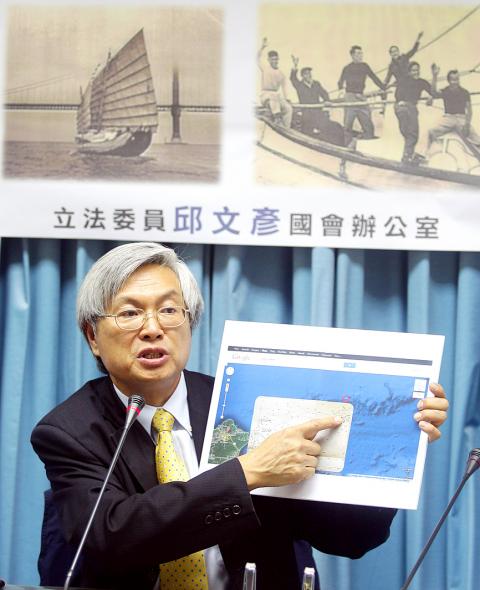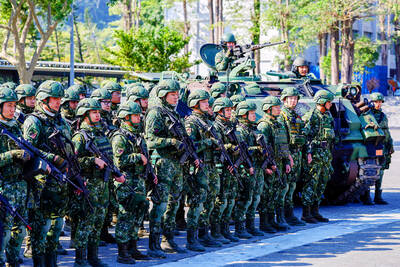A Chinese Nationalist Party (KMT) lawmaker yesterday presented his research involving a former US vice consul to Taiwan in the 1950s to show that the disputed Diaoyutai Islands (釣魚台) and its surrounding waters are traditional fishing grounds of Taiwanese fishermen.
Between April 17 and April 23, 1955, the Free China was anchored off the Diaoyutais along with a Taiwanese fishing boat and found that the islands had been used as a shelter by Taiwanese fishermen, KMT Legislator Chiu Wen-yen (邱文彥) said.
Chiu called the press conference to release his findings drawn from his research on the voyage of the Free China in 1955 and e-mail correspondence with Calvin Mehlert, then-US counsel to Taiwan, and Paul Chow (周傳鈞), two of the six crewmembers who made the trip from Taiwan to San Francisco that year.

Photo: CNA
The Free China, a wooden junk constructed in Mawei in China’s Fujian Province in 1890, was the first Taiwanese boat to successfully sail across the Pacific Ocean solely using its sails and was the only one of its kind.
With five young men and Mehlert on board, the Free China left Keelung Harbor on April 4, 1955, to take part in a sailing competition in the US. Although it was unable to make it to the race because it lacked modern equipment and encountered storms along the way, it beat all the odds to arrive in San Francisco after 114 days at sea.
The boat was transported back to Taiwan last month onboard a Yang Ming Marine Transport cargo ship from Oakland, California, and is undergoing restoration at the National Museum of Marine Science and Technology in Keelung.
Intrigued by the image of crewmember Benny Hsu (徐家政) sitting on a cliff on “No-Man Island” waving his hands in the feature-length film Free China Junk — which documented the journey and was directed by Robin Greenburg — Chiu, a marine scientist, said he was curious to know the location of the island.
Chiu said he presumed the “No-Man Island” was one of the Diaoyutai Islands after he found a photograph taken by Mehlert featuring a peculiar rock on the island that resembles other photographs of the Diaoyutais that he had seen.
Chiu said his presumption was confirmed after he checked the daily records of the Free China’s voyage, nautical charts for the voyage and descriptions about geographical characteristics of the island in other literature, adding that Mehlert and Chow corroborated his research.
In an e-mail reply to Chiu, Chow said he believed the “No-Man Island” was one of the Diaoyutai Islands and that when the Free China was anchored at the Diaoyutais, Mehlert made several trips ashore and found wreckage and skeletons.
Chow said “small-boat fishermen in Keelung, particularly harpooners, have been using it as a shelter for as long as we could remember in our history.”
Mehlert said in an e-mail reply to Chiu that: “To my mind, your and our photos are conclusive evidence that our wurendao [無人島, No-Man Island] is one of the Diaoyutais. There just aren’t any other small islands in that area.”
Chiu’s findings would help the government assert its claim to sovereignty over the Diaoyutais against Japan, said Wang Ching-hsiu (王靚琇), deputy director of the Department of Land Administration.
Beijing also claims sovereignty over the disputed islands.
In related news, several members of the Tokyo Metropolitan Assembly yesterday conducted an inspection trip to waters off the Diaoyutais, prompting the Taipei Economic and Cultural Representative Office in Tokyo to send a letter to the Japanese Ministry of Foreign Affairs to register its concerns over and protest against the move.
In Taipei, Ministry of Foreign Affairs spokesperson Steve Shia (夏季昌) reiterated that the Republic of China government has full sovereignty over the islands and opposes any infringement of the nation’s sovereign territory in the form of words or deeds.
Taiwan called on the Japanese government to “react cautiously” to acts performed by its politicians that were intended to infringe the sovereignty of the country and refrain from making moves to avoid any harmful impact on the relationship between Taiwan and Japan, Shia said.

UNILATERAL MOVES: Officials have raised concerns that Beijing could try to exert economic control over Kinmen in a key development plan next year The Civil Aviation Administration (CAA) yesterday said that China has so far failed to provide any information about a new airport expected to open next year that is less than 10km from a Taiwanese airport, raising flight safety concerns. Xiamen Xiangan International Airport is only about 3km at its closest point from the islands in Kinmen County — the scene of on-off fighting during the Cold War — and construction work can be seen and heard clearly from the Taiwan side. In a written statement sent to Reuters, the CAA said that airports close to each other need detailed advanced

Tropical Storm Fung-Wong would likely strengthen into a typhoon later today as it continues moving westward across the Pacific before heading in Taiwan’s direction next week, the Central Weather Administration (CWA) said. As of 8am, Fung-Wong was about 2,190km east-southeast of Cape Oluanpi (鵝鑾鼻), Taiwan’s southernmost point, moving westward at 25kph and possibly accelerating to 31kph, CWA data showed. The tropical storm is currently over waters east of the Philippines and still far from Taiwan, CWA forecaster Tseng Chao-cheng (曾昭誠) said, adding that it could likely strengthen into a typhoon later in the day. It is forecast to reach the South China Sea

WEATHER Typhoon forming: CWA A tropical depression is expected to form into a typhoon as early as today, the Central Weather Administration (CWA) said yesterday, adding that the storm’s path remains uncertain. Before the weekend, it would move toward the Philippines, the agency said. Some time around Monday next week, it might reach a turning point, either veering north toward waters east of Taiwan or continuing westward across the Philippines, the CWA said. Meanwhile, the eye of Typhoon Kalmaegi was 1,310km south-southeast of Oluanpi (鵝鑾鼻), Taiwan’s southernmost point, as of 2am yesterday, it said. The storm is forecast to move through central

Almost a quarter of volunteer soldiers who signed up from 2021 to last year have sought early discharge, the Legislative Yuan’s Budget Center said in a report. The report said that 12,884 of 52,674 people who volunteered in the period had sought an early exit from the military, returning NT$895.96 million (US$28.86 million) to the government. In 2021, there was a 105.34 percent rise in the volunteer recruitment rate, but the number has steadily declined since then, missing recruitment targets, the Chinese-language United Daily News said, citing the report. In 2021, only 521 volunteers dropped out of the military, the report said, citing